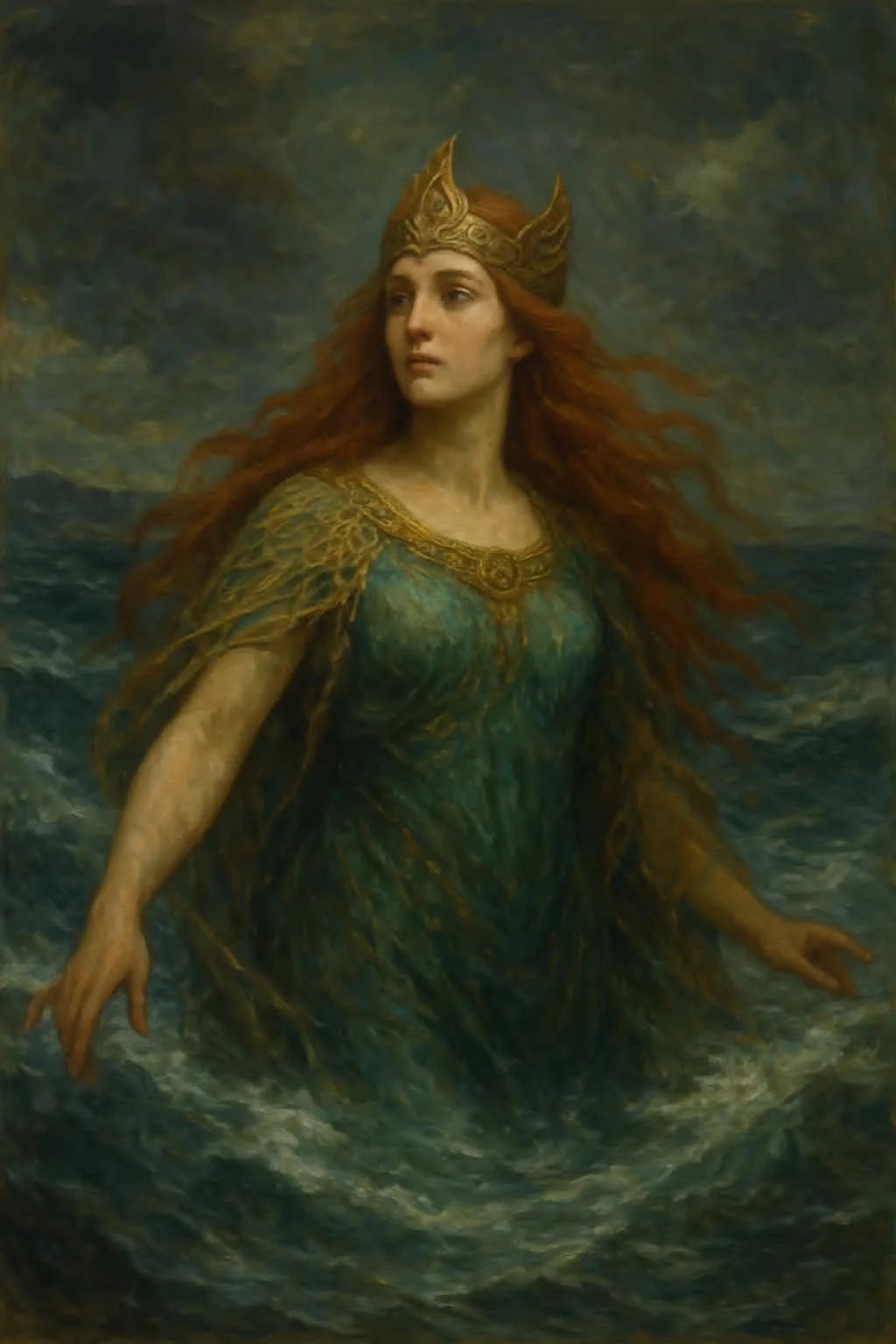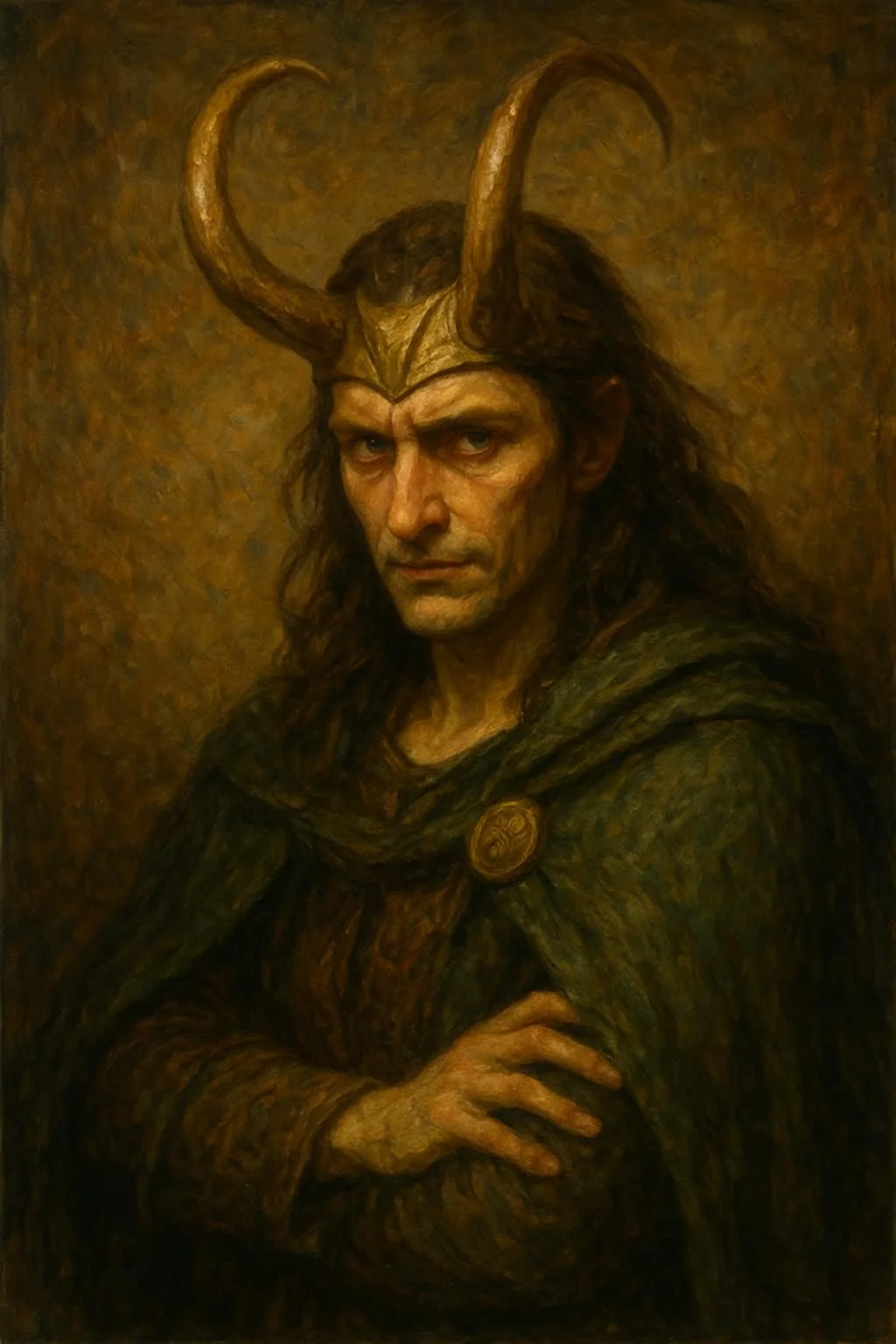
Víðarr: The Silent Avenger
Víðarr, the silent god of Norse myth, is power without spectacle - endurance shaped into destiny. Born of Odin and the giantess Gríðr, he stands as the still axis of the cosmos: listening, waiting, acting only when the world demands it. His symbol is a humble shoe, stitched from countless scraps of leather (quiet offerings gathered across ages) made to brace against Fenrir’s jaws at Ragnarök. In Víðarr, silence is not absence but presence; not weakness, but focus. He is aftermath rather than wrath, the strength that rebuilds when thunder fades. Surviving the world’s fire, he walks the new earth with unbroken patience, a living promise that balance returns through restraint. This is the lesson of Víðarr: that true might is accumulated in stillness, and from silence, renewal begins.

Ullr: The Silent Hunter of the North
Snow falls without a sound. In the deep silence of the North, where frost rules and breath turns to mist, a shadow glides across the frozen wilds. He leaves no footprints, speaks no words, and yet his presence is felt in every oath sworn and every arrow loosed. Ullr (the Silent Hunter, the Winter Sovereign, the god of precision and unbroken honour) moves between worlds with the calm of inevitability. Though the sagas speak little of him, the North remembers. In the stillness before action, in the discipline forged by cold, Ullr waits.

Bragi: The Voice Between Worlds
Bragi, the Norse god of poetry, is more than a keeper of songs- he is the voice that binds memory to meaning, story to soul. Where Thor wields thunder and Odin gathers wisdom, Bragi preserves what would otherwise be lost to silence. He turns deeds into legend, sorrow into song, and truth into immortal verse. In the halls of Asgard, he raises the bragarfull - the sacred cup of oaths - reminding gods and mortals alike that words carry power. Bragi is the muse of skalds, the guardian of story, and the living heartbeat of culture. Through him, poetry becomes more than art - it becomes survival against oblivion. This is Bragi: the voice between worlds.

Rán: The Sea’s Embrace and Terror
Beneath the waves, where silence turns to hunger, dwells Rán - the Norse goddess of the sea’s embrace and terror. With her shining net, she gathers the drowned, holding them in her cold but certain arms.
Rán is not mercy, nor cruelty - she is truth. The sea gives and the sea takes, and every voyage is sailed under her shadow. To the Norse, she was both feared and honoured, the dark mirror of the ocean’s depth and fate’s inevitability.
Her net is more than a weapon — it is wyrd itself, weaving every life and loss into the vast tapestry of the sea. Through her, we remember that every surrender, every ending, and every storm is part of a larger design.
To face Rán is to face the deep: to accept what we cannot control, to live fiercely even knowing the tide will one day claim us. 🌊

Frigg: The All-Mother, Weaver of Fates
Frigg is the unseen strength of the Norse cosmos — queen, mother, and silent knower of all fates. She weaves the threads that bind gods and mortals, shaping the world through patience, love, and foresight. From her hall of Fensalir, she watches destiny unfold, her silence as powerful as Odin’s wisdom or Thor’s hammer. In her story, we find the truth that endurance is its own kind of power — that to hold the world together, one need not roar, but weave.

Loki: The Flame Between Worlds
Loki: the flame in the dark, the spark of change, the whisper that shatters silence. Neither good nor evil, this restless god moves between worlds — shapeshifter, trickster, and bringer of both ruin and renewal.
In this in-depth exploration of Norse mythology, we trace Loki from the ancient Eddas to the fires of Ragnarök and beyond. You’ll meet the sly companion of Odin, the maker of miracles and monsters, the bound god beneath the earth, and the unbound flame who brings about the world’s end — and its rebirth.
Through myth, symbolism, and modern reflection, Loki: The Flame Between Worlds explores what the trickster teaches us today: that chaos is not the enemy of order, but its necessary partner.
Fire burns, but it also gives light. Loki reminds us that every ending is a beginning — and that the spark of change lives in all of us.

Thor: The Thunderer, Defender of Worlds
Thor, the mighty thunderer, is one of the most iconic gods in Norse mythology. Wielding his hammer Mjölnir and riding across the storm-tossed sky in a chariot drawn by goats, Thor embodies raw strength, protection, and defiance in the face of chaos. Beloved by farmers and feared by giants, he is the defender of both gods and humans, a force of thunder who blesses, hallows, and protects. This post explores Thor’s role as warrior, hall-companion, giant-slayer, and doomed hero, whose story still thunders across time.

Hel – Queen of the Dead, Guardian of the Hidden Realm
Hel, daughter of Loki and Angrboða, rules over Helheim, the Norse realm of the dead. With her half-living, half-dead form, she embodies the boundary between life and death. Unlike Valhalla or Fólkvangr, her domain welcomed those who died of age, illness, or misfortune, offering a neutral afterlife rather than torment. Hel played a pivotal role in the death of Baldr and will rise again during Ragnarök, leading an army of the dead. As goddess of inevitability and transition, Hel reminds us that death is not the end but part of the eternal cycle of existence.

Freyja – Lady of Love, War, and Magic
Freyja, the radiant Lady of the Vanir, is one of the most powerful and captivating goddesses in Norse mythology. Known as the goddess of love, beauty, fertility, sorcery, war, and death, she embodies the full spectrum of human existence — sensual yet fierce, nurturing yet destructive. With her falcon-cloak, her cat-drawn chariot, and the fabled Brísingamen necklace, Freyja shaped the lives of gods and mortals alike. She chose half of the slain for her hall in Fólkvangr, taught Odin the mysteries of seiðr, and remains one of the most revered deities of the old ways.

Heimdall, the Watchman of the Gods
Heimdall, the shining guardian of Asgard, is one of the most fascinating figures in Norse mythology. Born of nine mothers at the edge of the world, he became the divine watchman, gifted with unmatched sight and hearing. From fathering the classes of humanity in Rígsþula to blowing the Gjallarhorn at Ragnarök, Heimdall stands as a symbol of vigilance, loyalty, and sacrifice. His final battle with Loki captures the eternal struggle between order and chaos, reminding us of the timeless need for guardians who keep the balance between light and shadow.

Odin, the Allfather - The one eyed God of the north
Odin, the Allfather of Norse mythology, is the one-eyed god of wisdom, war, poetry, and magic. Unlike his son Þórr, who rules with strength, Odin relies on cunning, sacrifice, and secret knowledge. Followed by his ravens Huginn and Muninn and his wolves Geri and Freki, he reigns over Valhalla, guiding the souls of fallen warriors. With countless names and ancient roots stretching back to the earliest Germanic peoples, Odin embodies both fury and inspiration, both ruthless ruler and restless wanderer. His myths reveal a god who sacrifices endlessly in his pursuit of wisdom, shaping him into one of the most complex and enduring figures of the Norse pantheon.

Tyr: The God Who Chose Honour Over Power
In Norse mythology, Týr is one of the most ancient and complex gods — a figure of law, war, sacrifice, and sacred oaths. Long before Odin rose to prominence, echoes of Týr can be traced back to Proto-Indo-European Dyeus, the primordial sky father, placing him among the oldest deities of the Germanic world. By the Viking Age, his role had become more focused: he was the god of justice, of binding contracts, of courage in the face of impossible choices.
Unlike Odin, who seeks knowledge through cunning, or Thor, who wins by force, Týr embodies principle above power. His defining myth is the binding of Fenrir, when he placed his hand in the wolf’s jaws as a pledge of good faith, knowing he would lose it. He did so not for glory, but because no one else would. In that sacrifice, he became the one-handed god of truth, the divine guarantor of oaths, and the patron of those who choose honor even when it costs them everything.
Týr reminds us that real strength is not always loud, and that the most sacred truths often require loss. He is the quiet, unshakable force of integrity — the god who stands where others falter, who binds chaos not for praise, but for balance.

The Beloved God Baldr: Light, Hope, and Tragedy in Norse Mythology
Baldr, the radiant god of light, joy, and purity, stands as one of the most beloved figures in Norse mythology. Son of Óðinn and Frigg, he embodied beauty and nobility so great that even the flowers were said to bow as he passed. Yet despite his perfection, Baldr’s greatest role was tragically to die - his fate sealed by mistletoe, Loki’s trickery, and the hand of his blind brother Höðr. His death set in motion the events of Ragnarök and became a timeless story of vulnerability, betrayal, and destiny. In exploring Baldr’s tale, we find lessons not only of sorrow but also of hope, light, and resilience that continue to inspire today.

Gullveig: The Witch Who Shaped the Fate of the Gods
✨ Gullveig: The Volva Who Shaped the Fate of the Gods ✨
Few figures in Norse mythology carry as much mystery—or as much weight—as Gullveig. Burned three times and reborn from the flames, she embodies truth, transformation, and the dangerous power of seiðr.
Her presence shattered the fragile balance between the Æsir and Vanir, igniting the only great war among the gods. She is both victim and catalyst, a mirror of greed and corruption, and a weaver of golden threads that bind even the gods to their fates.
Was she a Vanir witch? A forgotten Norn? An early form of Freyja herself?
What we know is this: without Gullveig, the mythic struggle that drives the fate of the cosmos—and Ragnarök itself—would never have begun.

